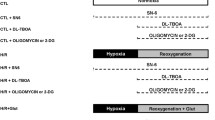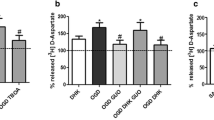Abstract
Stroke is a major cause of disability and death worldwide. Oxygen and glucose deprivation (OGD) in brain tissue preparations can reproduce several pathological features induced by stroke providing a valuable ex vivo protocol for studying the mechanism of action of neuroprotective agents. Guanosine, an endogenous guanine nucleoside, promotes neuroprotection in vivo and in vitro models of neurotoxicity. We previously showed that guanosine protective effect was mimicked by inhibition of nitric oxide synthases (NOS) activity. This study was designed to investigate the involvement of nitric oxide (NO) in the mechanisms related to the protective role of guanosine in rat hippocampal slices subjected to OGD followed by reoxygenation (OGD/R). Guanosine (100 μM) and the pan-NOS inhibitor, l-NAME (1 mM) afforded protection to hippocampal slices subjected to OGD/R. The presence of NO donors, DETA-NO (800 μM) or SNP (5 μM) increased reactive species production, and abolished the protective effect of guanosine or l-NAME against OGD/R. Guanosine or l-NAME treatment prevented the impaired ATP production, lactate release, and glutamate uptake following OGD/R. The presence of a NO donor also abolished the beneficial effects of guanosine or l-NAME on bioenergetics and glutamate uptake. These results showed, for the first time, that guanosine may regulate cellular bioenergetics in hippocampal slices subjected to OGD/R injury by a mechanism that involves the modulation of NO levels.






Similar content being viewed by others
Abbreviations
- ATP:
-
Adenosine-5′-triphosphate
- DCFH:
-
2′,7′-Dichlorodihydrofluorescein
- DETA-NO:
-
(Z)-1-[N-(2-Aminoethyl)-N-(2-ammonioethyl) amino] diazen-1-ium-1,2-diolate
- OGD:
-
Oxygen and glucose deprivation
- OGD/R:
-
Oxygen and glucose deprivation followed by reoxygenation
- iNOS:
-
Inducible nitric oxide synthase
- I/R:
-
Ischemia and reperfusion
- KRB:
-
Krebs–Ringer bicarbonate buffer
- L-NAME:
-
l-NG-nitro-l-arginine methyl ester
- MTT:
-
3-(4,5-Dimethylthiazol-2-yl)-2,5-diphenyltetrazolium bromide
- nNOS:
-
Neuronal nitric oxide synthase
- NO:
-
Nitric oxide
- NOS:
-
Nitric oxide synthase
- SNP:
-
Sodium nitroprusside
- 14C-2-DG:
-
[U-14C]-2-deoxy-d-glucose
References
Benjamin EJ et al (2017) Heart disease and stroke statistics-2017 update: a report from the American Heart Association. Circulation 135(10):e146–e603
Donnan GA et al (2008) Stroke. Lancet 371(9624):1612–1623
Iadecola C, Alexander M (2001) Cerebral ischemia and inflammation. Curr Opin Neurol 14(1):89–94
Schaller B, Graf R (2004) Cerebral ischemia and reperfusion: the pathophysiologic concept as a basis for clinical therapy. J Cereb Blood Flow Metab 24(4):351–371
Sommer CJ (2017) Ischemic stroke: experimental models and reality. Acta Neuropathol 133(2):245–261
Holloway PM, Gavins FN (2016) Modeling ischemic stroke in vitro: status quo and future perspectives. Stroke 47(2):561–569
Tasca CI, Dal-Cim T, Cimarosti H (2015) In vitro oxygen-glucose deprivation to study ischemic cell death. Methods Mol Biol 1254:197–210
Doyle KP, Simon RP, Stenzel-Poore MP (2008) Mechanisms of ischemic brain damage. Neuropharmacology 55(3):310–318
Brown GC (2010) Nitric oxide and neuronal death. Nitric Oxide 23(3):153–165
Moro MA et al (2004) Role of nitric oxide after brain ischaemia. Cell Calcium 36(3–4):265–275
Almeida A, Moncada S, Bolaños JP (2004) Nitric oxide switches on glycolysis through the AMP protein kinase and 6-phosphofructo-2-kinase pathway. Nat Cell Biol 6(1):45–51
Almeida A et al (2001) Different responses of astrocytes and neurons to nitric oxide: the role of glycolytically generated ATP in astrocyte protection. Proc Natl Acad Sci USA 98(26):15294–15299
Campbell BCV et al (2019) Ischaemic stroke. Nat Rev Dis Primers 5(1):1–22
Dienel GA (2018) Brain glucose metabolism: integration of energetics with function. Physiol Rev 99(1):949–1045
Magistretti P, Allaman I (2018) Lactate in the brain: from metabolic end-product to signalling molecule. Nat Rev Neurosci 19(4):235–249
Schurr A, Gozal E (2011) Aerobic production and utilization of lactate satisfy increased energy demands upon neuronal activation in hippocampal slices and provide neuroprotection against oxidative stress. Front Pharmacol 2:96
Castillo X et al (2015) A probable dual mode of action for both l- and d-lactate neuroprotection in cerebral ischemia. J Cereb Blood Flow Metab 35(10):1561–1569
Magistretti PJ et al (1999) Energy on demand. Science 283(5401):496–497
Bolanos JP (2016) Bioenergetics and redox adaptations of astrocytes to neuronal activity. J Neurochem 139(Suppl 2):115–125
Voutsinos-Porche B et al (2003) Glial glutamate transporters mediate a functional metabolic crosstalk between neurons and astrocytes in the mouse developing cortex. Neuron 37(2):275–286
Grupke S et al (2015) Understanding history, and not repeating it. Neuroprotection for acute ischemic stroke: from review to preview. Clin Neurol Neurosurg 129:1–9
Molz S et al (2005) Neurotoxicity induced by glutamate in glucose-deprived rat hippocampal slices is prevented by GMP. Neurochem Res 30(1):83–89
Oleskovicz SP et al (2008) Mechanism of guanosine-induced neuroprotection in rat hippocampal slices submitted to oxygen-glucose deprivation. Neurochem Int 52(3):411–418
Schmidt AP et al (2000) Guanosine and GMP prevent seizures induced by quinolinic acid in mice. Brain Res 864(1):40–43
Decker H et al (2019) Guanosine and GMP increase the number of granular cerebellar neurons in culture: dependence on adenosine A 2A and ionotropic glutamate receptors. Purinergic Signal 15(4):439–450
Schmidt AP, Lara DR, Souza DO (2007) Proposal of a guanine-based purinergic system in the mammalian central nervous system. Pharmacol Ther 116(3):401–416
Lanznaster D et al (2016) Guanosine: a neuromodulator with therapeutic potential in brain disorders. Aging Dis 7(5):657–679
Dal-Cim T et al (2016) Neuroprotection promoted by guanosine depends on glutamine synthetase and glutamate transporters activity in hippocampal slices subjected to oxygen/glucose deprivation. Neurotox Res 29(4):460–468
Dal-Cim T et al (2011) Guanosine is neuroprotective against oxygen/glucose deprivation in hippocampal slices via large conductance Ca2+-activated K+ channels, phosphatidilinositol-3 kinase/protein kinase B pathway activation and glutamate uptake. Neuroscience 183:212–220
Dal-Cim T et al (2013) Guanosine controls inflammatory pathways to afford neuroprotection of hippocampal slices under oxygen and glucose deprivation conditions. J Neurochem 126(4):437–450
Molz S et al (2011) Neuroprotective effect of guanosine against glutamate-induced cell death in rat hippocampal slices is mediated by the phosphatidylinositol-3 kinase/Akt/glycogen synthase kinase 3β pathway activation and inducible nitric oxide synthase inhibition. J Neurosci Res 89(9):1400–1408
Thomaz DT et al (2016) Guanosine prevents nitroxidative stress and recovers mitochondrial membrane potential disruption in hippocampal slices subjected to oxygen/glucose deprivation. Purinergic Signal 12(4):707–718
Koellhoffer EC, McCullough LD (2012) The effects of estrogen in ischemic stroke. Transl Stroke Res 4(4):390–401
Hurn PD, Macrae IM (2000) Estrogen as a neuroprotectant in stroke. J Cereb Blood Flow Metab 20(4):631–652
Pocock JM, Nicholls DG (1998) Exocytotic and nonexocytotic modes of glutamate release from cultured cerebellar granule cells during chemical ischaemia. J Neurochem 70(2):806–813
Liu Y et al (1997) Mechanism of cellular 3-(4,5-dimethylthiazol-2-yl)-2,5-diphenyltetrazolium bromide (MTT) reduction. J Neurochem 69(2):581–593
Oliveira IJ et al (2002) Neuroprotective effect of GMP in hippocampal slices submitted to an in vitro model of ischemia. Cell Mol Neurobiol 22(3):335–344
Cazarolli LH et al (2009) Mechanism of action of the stimulatory effect of apigenin-6-C-(2″-O-alpha-l-rhamnopyranosyl)-beta-l-fucopyranoside on 14C-glucose uptake. Chem Biol Interact 179(2–3):407–412
Molz S, Dal-Cim T, Tasca CI (2009) Guanosine-5′-monophosphate induces cell death in rat hippocampal slices via ionotropic glutamate receptors activation and glutamate uptake inhibition. Neurochem Int 55(7):703–709
Peterson GL (1977) A simplification of the protein assay method of Lowry et al. which is more generally applicable. Anal Biochem 83(2):346–356
Lowry OH et al (1951) Protein measurement with the Folin phenol reagent. J Biol Chem 193(1):265–275
Godínez-Rubí M, Rojas-Mayorquín AE, Ortuño-Sahagún D (2013) Nitric oxide donors as neuroprotective agents after an ischemic stroke-related inflammatory reaction. Oxid Med Cell Longev 2013:297357
Marcillac F et al (2011) Nitric oxide induces the expression of the monocarboxylate transporter MCT4 in cultured astrocytes by a cGMP-independent transcriptional activation. Glia 59(12):1987–1995
Khan M et al (2006) Cerebrovascular protection by various nitric oxide donors in rats after experimental stroke. Nitric Oxide 15(2):114–124
Iadecola C (1997) Bright and dark sides of nitric oxide in ischemic brain injury. Trends Neurosci 20(3):132–139
Patel RAG, McMullen PW (2017) Neuroprotection in the treatment of acute ischemic stroke. Prog Cardiovasc Dis 59(6):542–548
Di Liberto V et al (2016) The guanine-based purinergic system: the tale of an orphan neuromodulation. Front Pharmacol 7:158
Chang R et al (2008) Neuroprotective effects of guanosine on stroke models in vitro and in vivo. Neurosci Lett 431(2):101–105
Connell BJ et al (2013) Guanosine protects against reperfusion injury in rat brains after ischemic stroke. J Neurosci Res 91(2):262–272
Rathbone MP et al (2011) Systemic administration of guanosine promotes functional and histological improvement following an ischemic stroke in rats. Brain Res 1407:79–89
Endres M et al (2004) Targeting eNOS for stroke protection. Trends Neurosci 27(5):283–289
Terpolilli NA et al (2012) Inhalation of nitric oxide prevents ischemic brain damage in experimental stroke by selective dilatation of collateral arterioles. Circ Res 110(5):727–738
Bath PM, Krishnan K, Appleton JP (2017) Nitric oxide donors (nitrates), l-arginine, or nitric oxide synthase inhibitors for acute stroke. Cochrane Database Syst Rev 4:CD000398
Almeida A et al (2005) Inhibition of mitochondrial respiration by nitric oxide: its role in glucose metabolism and neuroprotection. J Neurosci Res 79(1–2):166–171
Escartin C et al (2006) Neuron-astrocyte interactions in the regulation of brain energy metabolism: a focus on NMR spectroscopy. J Neurochem 99(2):393–401
Vannucci SJ, Seaman LB, Vannucci RC (1996) Effects of hypoxia-ischemia on GLUT1 and GLUT3 glucose transporters in immature rat brain. J Cereb Blood Flow Metab 16(1):77–81
Pellerin L, Magistretti PJ (1994) Glutamate uptake into astrocytes stimulates aerobic glycolysis: a mechanism coupling neuronal activity to glucose utilization. Proc Natl Acad Sci USA 91(22):10625–10629
Dienel GA, Cruz NF (1993) Synthesis of deoxyglucose-1-phosphate, deoxyglucose-1,6-bisphosphate, and other metabolites of 2-deoxy-d-[14C]glucose in rat brain in vivo: influence of time and tissue glucose level. J Neurochem 60(6):2217–2231
Ralser M et al (2008) A catabolic block does not sufficiently explain how 2-deoxy-d-glucose inhibits cell growth. Proc Natl Acad Sci USA 105(46):17807–17811
Cavalcanti-de-Albuquerque JP et al (2018) Mitochondria-bound hexokinase (mt-HK) activity differ in cortical and hypothalamic synaptosomes: differential role of mt-HK in H2O2 depuration. Mol Neurobiol 55(7):5889–5900
Raju K et al (2015) Regulation of brain glutamate metabolism by nitric oxide and S-nitrosylation. Sci Signal 8(384):ra68
Danbolt NC (2001) Glutamate uptake. Prog Neurobiol 65(1):1–105
Dal-Cim T et al (2019) Guanosine prevents oxidative damage and glutamate uptake impairment induced by oxygen/glucose deprivation in cortical astrocyte cultures: involvement of A1 and A2A adenosine receptors and PI3K, MEK, and PKC pathways. Purinergic Signal 15(4):465–476
Huang Z et al (1994) Effects of cerebral ischemia in mice deficient in neuronal nitric oxide synthase. Science 265(5180):1883–1885
Sattler R et al (1999) Specific coupling of NMDA receptor activation to nitric oxide neurotoxicity by PSD-95 protein. Science 284(5421):1845–1848
Jacoby S, Sims RE, Hartell NA (2001) Nitric oxide is required for the induction and heterosynaptic spread of long-term potentiation in rat cerebellar slices. J Physiol 535(Pt 3):825–839
Dawson VL et al (1991) Nitric oxide mediates glutamate neurotoxicity in primary cortical cultures. Proc Natl Acad Sci USA 88(14):6368–6371
Almeida A et al (1998) Glutamate neurotoxicity is associated with nitric oxide-mediated mitochondrial dysfunction and glutathione depletion. Brain Res 790(1–2):209–216
Acknowledgements
Research supported by grants from the Brazilian funding agencies to C.I.T: CNPq (Conselho Nacional de Desenvolvimento Científico e Tecnológico) –INCT for Excitotoxicity and Neuroprotection; CNPq Productivity Fellowship. D.T.T. is recipient of PhD fellowship from CAPES (Coordenação de Aperfeiçoamento de Pessoal de Ensino Superior). The authors would like to express their acknowledgments to Dr. A. Latini for her critical analysis.
Author information
Authors and Affiliations
Corresponding author
Ethics declarations
Conflict of interest
The authors state no conflicts of interest. All authors have materially participated in the research and/or article preparation.
Additional information
Publisher's Note
Springer Nature remains neutral with regard to jurisdictional claims in published maps and institutional affiliations.
Rights and permissions
About this article
Cite this article
Thomaz, D.T., Andreguetti, R.R., Binder, L.B. et al. Guanosine Neuroprotective Action in Hippocampal Slices Subjected to Oxygen and Glucose Deprivation Restores ATP Levels, Lactate Release and Glutamate Uptake Impairment: Involvement of Nitric Oxide. Neurochem Res 45, 2217–2229 (2020). https://doi.org/10.1007/s11064-020-03083-2
Received:
Revised:
Accepted:
Published:
Issue Date:
DOI: https://doi.org/10.1007/s11064-020-03083-2




